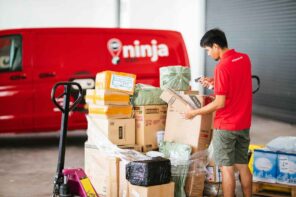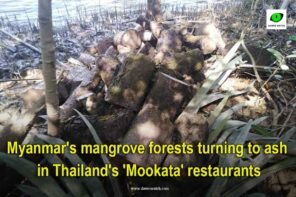The entrance sign to Thayetchaung Township in Dawei is proudly adorned with a sculpture of a pile of durians.
The Tanintharyi region is an area where durian trees are cultivated and thrive.
In particular, the areas of Yebyu, Thayetchaung, Tanintharyi and Dawei are renowned for producing durians with an exceptional taste.
However, at present, locally produced durians are being overshadowed by imported, grafted, hybrid varieties.
Although the durian tree is not native to the Dawei area or Myanmar, it has been growing and thriving in the Dawei area for decades, which is why it is referred to as a local variety.
But now, durian growers are increasingly opting to cultivate grafted generations from Malaysia and Thailand instead of the local durian trees, that have been growing wild in the region for decades.
Homegrown versus imports
When comparing local durians to the foreign grafted varieties, each has its own strengths and weaknesses.
Thai Mon Thong and Malaysian Musang King (locally known as Su Mae or Black Thorn) were the most widely cultivated species in Myanmar, including in the Tanintharyi region.
These varieties were a profitable export because they tasted good, had small seeds and thick flesh, gave a good yield and were perennial trees.
The climate and soil in the Tanintharyi region is suitable for durian cultivation, and there is high potential for successfully cultivating high-quality foreign varieties.
Some durian orchard owners say the main weaknesses of the Dawei durian are its inconsistent smell and taste, and its irregular yield.
They also say the yield and taste of the local durian fruit depended entirely on the weather.
“If the weather is not good, the fruit yield is low. If it rains too much, water gets into the durian and the taste is ruined. When that happens, you can’t get the price you want,” said the owner of a durian orchard in Launglon Township.
Some orchard owners have concluded that for these reasons the higher quality durians like Mon Thong from Thailand and Musang King from Malaysia have gained a foothold in the Tanintharyi market, and the number of local cultivators is also likely increasing.
The struggling local durians
Durian from Thailand and Malaysia are now circulating globally, having been technologically enhanced for high quality.
As the soil in the Tanintharyi region is suitable for durian cultivation, it is also an area where durians have been cultivated for many years. However, local durians were cheap and the market was unstable, so they are gradually losing their place, even in the local market.
Thailand’s Mon Thong and Malaysia’s Musang King sell for more than 10,000 kyats per kilogram. As these durians often weigh more than three kilograms each, one single fruit sells for a minimum of 30,000 to 50,000 or 60,000 kyats, depending on the weight per kilo.
The price for local durian, however, typically does not exceed a few thousand.
“This year the price has been very low. A big durian can only fetch about 2,000 kyats,” complained Ko Htet, a durian farm owner from Tanintharyi Township.
According to interviews with durian growers and orchard owners in the five townships of Dawei, Launglon, Yebyu, Thayetchaung and Tanintharyi in the region, almost no one is replanting local durian.
Although there are still a few growers, most still plant them traditionally using the seed method. However, two people are now cultivating local varieties using grafting technology.
One is agricultural expert U Nay Lin Aung. He has cultivated a durian species from the Kaleinaung area using grafting and propagation techniques. He has named it Aung Zabu (Durian of Victory).
“The trees are now four years old, and they’ve started bearing fruit,” said U Nay Lin Aung.
The other is an unnamed agribusiness owner who is said to have cultivated about 700 local durian trees. Most southerners prefer to eat durian with a slightly bitter taste.
Ko Thar Gyi Lay, the durian cultivation service provider, said this type of taste cannot be provided by foreign varieties, only by local durian.
“The local fruit has sweet-bitter, bitter, astringent tastes, and these flavors cannot be found in foreign fruit,” he said.
Impact on the natural environment
Although no detailed environmental studies have been conducted on foreign grafted durians in the region, experts note they are typically cultivated with the heavy use of chemical fertilizers and pesticides to maximize yields.
“When cultivating grafted varieties, if they start using excessive chemical fertilizers and pesticides, then that is harmful agriculture,” warned a seed expert.
On the Launglon peninsula, companies often pre-purchase the fruit from foreign grafted durian trees.
They sign annual purchase contracts and then that company typically sends various pesticides and chemical fertilizers to the local durian orchard owner with instructions on how to use them.
Local durian orchard owners say this is the only way the company can get the desired fruit size and quantity.
“These plants (foreign grafted durians) only yield good fruit if you can apply fertilizers and pesticides at the right time,” said one orchard owner.
It was pointed out that local durian trees, being resilient to weather conditions, have a positive impact on the environment, including the potential to reduce the use of chemical fertilizers and pesticides.
“Plants suited to the local climate have greater resilience,” the seed expert said.
Local durians reduced to paste
Growing market demand is pushing more farmers toward foreign varieties, but this shift brings adverse effects such as heavier fertilizer and pesticide use, ecosystem damage and the loss of indigenous durians.
If systematic efforts are not made to make local varieties marketable, the local durians that have grown and survived for many years will not be able to compete with foreign grafted varieties. If things continue as they are, local durian will reach a point of near extinction.
At present, local durians are not as popular or as highly priced as Mon Thong or Musang King durians, so they are being made into durian paste for sale.
Although it is said that one viss (approximately 1.6 kg) of durian paste sells for fifty thousand kyats, that price is only equivalent to one Mon Thong fruit.
Producing one viss of durian paste requires many durians and additional inputs, including labor.
Furthermore, the intense fighting after the 2021 military coup has caused transportation difficulties, adding to the troubles of durian farmers.
Locals are not left with many choices. If they hold on to local durians, they not only fail to get a good price, but also, due to market access difficulties, they have no option but to make durian paste and sell it for whatever price they can get.
Facing these difficulties, a durian orchard owner in Bokepyin Township noted with frustration: “It doesn’t help to send it to other regions either. The transportation situation is unreliable. If you properly prepare durian paste, it can last for a year or two.”
Without urgent conservation and market support, Tanintharyi’s local durians may vanish, along with their unique flavors and environmental benefits.







